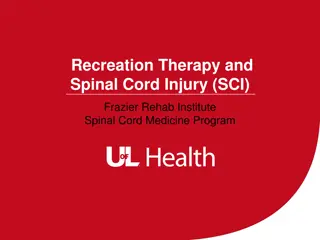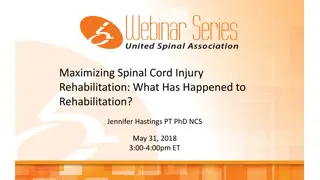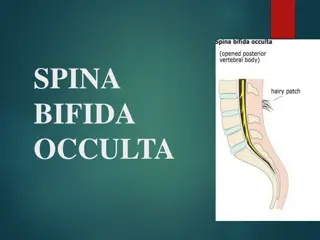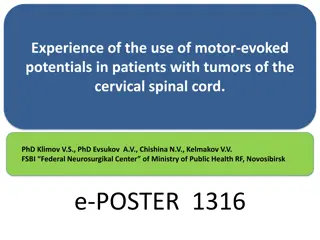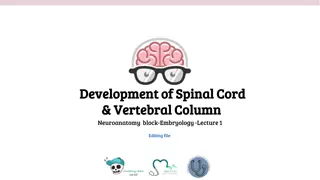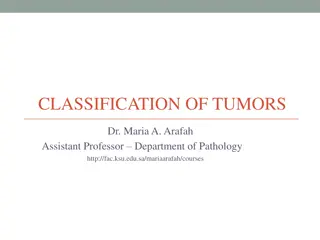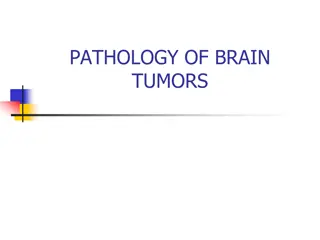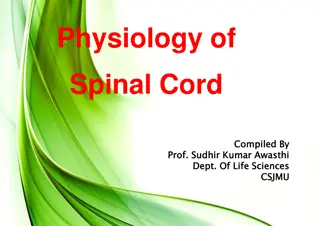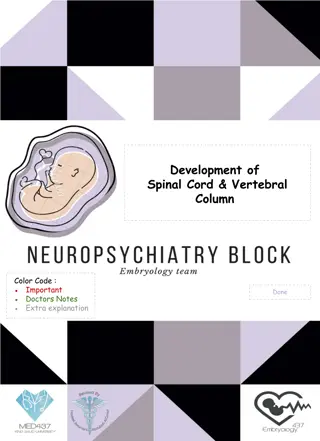Spinal Cord Tumors Overview
Spinal cord tumors can be primary or secondary, with metastatic tumors more common in young and middle-aged adults. Symptoms vary depending on tumor location and type, including pain, weakness, numbness, and difficulty walking. Treatment aims to reduce symptoms, manage pain, and improve mobility. Different types of spinal tumors exist, such as intradural-extramedullary and intramedullary tumors. Statistics show a significant number of diagnosed cases, with males and females being affected differently.
Download Presentation

Please find below an Image/Link to download the presentation.
The content on the website is provided AS IS for your information and personal use only. It may not be sold, licensed, or shared on other websites without obtaining consent from the author.If you encounter any issues during the download, it is possible that the publisher has removed the file from their server.
You are allowed to download the files provided on this website for personal or commercial use, subject to the condition that they are used lawfully. All files are the property of their respective owners.
The content on the website is provided AS IS for your information and personal use only. It may not be sold, licensed, or shared on other websites without obtaining consent from the author.
E N D
Presentation Transcript
Spinal Cord Tumors By: Aunshka Collins
Central Nervous System (CNS) Brain Sensory information (i.e., touch, hearing, taste, vision) Thoughts, memory, emotion, speech, movement Control center
Central Nervous System Spinal Cord Main pathway for information connecting the brain and the peripheral nervous system
Overview of Spinal Cord Tumors Abnormal growths found in or surrounding the spinal cord Tumors can be considered primary or secondary Metastatic spinal tumors are more common in young and middle-aged adults Tumors that have spread to the spine from another site often progress quickly These secondary tumors most frequently result from lung, prostate, or breast cancer Treatment, recovery, and survival depends on the tumor: Location Size Type Age The primary goal of treatment is to reduce the severity of symptoms Lessen pain Restore spine stability/improve mobility
Common Symptoms Symptoms depend on the location, type of tumor, and over all health General loss of sensations Pain (back, neck, arm, and legs) Muscle weakness Numbness Difficulty walking Loss of bowel or bladder function
Types of Spinal Tumors Intradural-Extramedullary Tumors Meningiomas Arise from the arachnoid mater which is a thin layer of the spinal cord located inside the dura Most common in middle aged and elderly women Nerve sheaths tumor (e.g., schwannomas and neurofibromas Arise from the nerve roots which come off the spinal cord Both meningiomas are benign Intramedullary Tumors Arise from supporting glia cells within the spinal cord Astrocytomas and ependymomas account for the majority of these tumors Tumors are usually benign
Statistics Estimates for brain and spinal cord tumors in the United States for 2013 (including both adults and children) are: 23,130 malignant tumors 12,770 in males and 10,360 in females will be diagnosed 14,080 people 7,930 males and 6,150 females will die from these tumors. Overall, the chance that a person will develop a malignant tumor of the brain or spinal cord in his or her lifetime is less than 1% 1 in 140 for a man and 1 in 180 for a woman
References http://emedicine.medscape.com/article/249306-overview http://psychology-studyofthesoul.tumblr.com/post/32992190012/what-your-central-nervous-system-cns-looks http://www.mayoclinic.com/health/spinal-tumor/DS00594/DSECTION=causes http://nyp.org/services/oncology/spinal-tumors-cancer.html http://www.allinahealth.org/ac/strokemanual.nsf/page/brain_parts http://climatereview.net/ChewTheFat/?p=1015 http://faculty.washington.edu/chudler/spinal.html http://www.med.umich.edu/lrc/coursepages/m1/anatomy2010/html/modules/spinal_cord_module/spinalcord_0 1.html http://cancer.osu.edu/patientsandvisitors/cancerinfo/cancertypes/spine_tumors/spine_tumors_faq/pages/index. aspx http://www.nlm.nih.gov/medlineplus/ency/article/001403.htm http://www.drugs.com/health-guide/spinal-cord-tumors.html http://www.aboutcancer.com/spinal_cord_anatomy.htm http://www.medicalook.com/Neurological_disorders/Spinal_cord_injuries.html https://www.google.com/search?q=nervous+system+tumor&client=firefox-a&hs=1px&rls=org.mozilla:en- US:official&source=lnms&tbm=isch&sa=X&ei=BHEXU7bbN4TXkQfnhIHgDQ&ved=0CAkQ_AUoAQ&biw=1275&bih= 859#q=nervous+system+brain+and+spinal+cord&rls=org.mozilla:en- US:official&tbm=isch&facrc=_&imgdii=wTRSMnAHt_FV8M%3A%3BbMqmDz9puQpNpM%3BwTRSMnAHt_FV8M% 3A&imgrc=wTRSMnAHt_FV8M%253A%3BrLz0FM5E31RIuM%3Bhttp%253A%252F%252F31.media.tumblr.com%25 2Ftumblr_l7b8swNn8f1qbub56o1_500.jpg%3Bhttp%253A%252F%252Fhouseofmind.tumblr.com%252Fpost%252F 967928682%252Fim-pretty-sure-this-was-taken-at-a-bodies%3B500%3B375 http://www.columbianeurosurgery.org/conditions/spinal-tumors/






